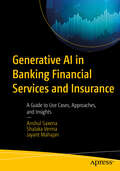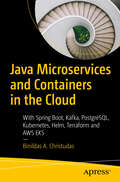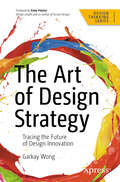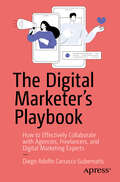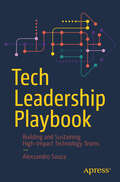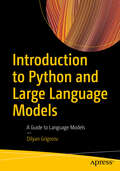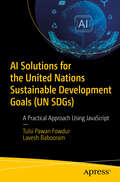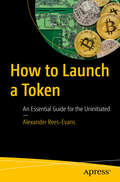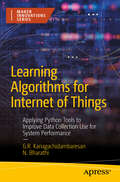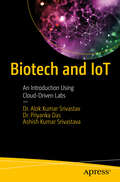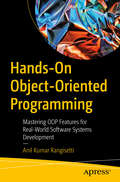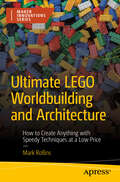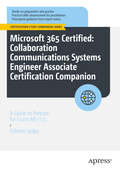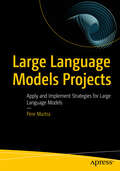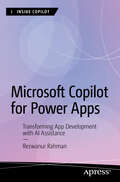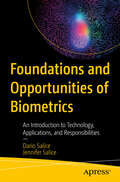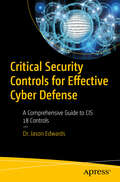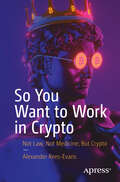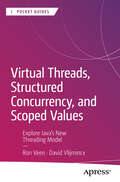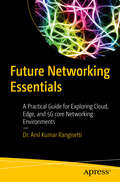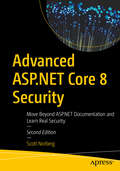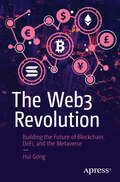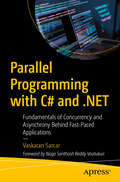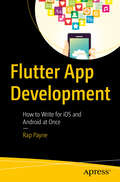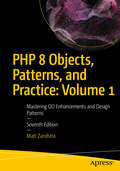- Table View
- List View
Generative AI in Banking Financial Services and Insurance: A Guide to Use Cases, Approaches, and Insights
by Anshul Saxena Shalaka Verma Jayant MahajanThis book explores the integration of Generative AI within the Banking, Financial Services, and Insurance (BFSI) sector, elucidating its implications, applications, and the future landscape of BFSI. The first part delves into the origins and evolution of Generative AI, providing insights into its mechanics and applications within the BFSI context. It goes into the core technologies behind Generative AI, emphasizing their significance and practical applications. The second part explores how Generative AI intersects with core banking processes, ranging from transactional activities to customer support, credit assessment, and regulatory compliance. It focuses on the digital transformation driving investment banking into the future. It also discusses AI’s role in algorithmic trading, client interactions, and regulatory adaptations. It analyzes AI-driven techniques in portfolio management, customer-centric solutions, and the next-generation approach to financial planning and advisory matters. The third part equips you with a structured roadmap for AI adoption in BFSI, highlighting the steps and the challenges. It outlines clear steps to assist BFSI institutions in incorporating Generative AI into their operations. It also raises awareness about the moral implications associated with AI in the BFSI sector. By the end of this book you will understand Generative AI’s present and future role in the BFSI sector. What You Will Learn Know what Generative AI is and its applications in the BFSI sector Understand deep learning and its significance in generative models Analyze the AI-driven techniques in portfolio management and customer-centric solutions Know the future of investment banking and trading with AI Know the challenges of integrating AI into the BFSI sector Who This Book Is For Professionals in the BFSI and IT sectors, including system administrators and programmers
Java Microservices and Containers in the Cloud: With Spring Boot, Kafka, PostgreSQL, Kubernetes, Helm, Terraform and AWS EKS
by Binildas A. ChristudasSpring Boot helps developers create applications that simply run. When minimal configuration is required to start up an application, even novice Java developers are ready to start. But this simplicity shouldn't constrain developers in addressing more complex enterprise requirements where microservice architecture is concerned. With the need to rapidly deploy, patch, or scale applications, containers provide solutions which can accelerate development, testing as well as production cycles. The cloud helps companies to scale and adapt at speed, accelerate innovation and drive business agility, without heavy upfront IT investment. What if we can equip even a novice developer with all that is required to help enterprises achieve all of this, this book does this and more. Java Microservices and Containers in the Cloud offers a comprehensive guide to both architecture and programming aspects to Java microservices development, providing a fully hands-on experience. We not only describe various architecture patterns but also provide practical implementations of each pattern through code examples. Despite the focus on architecture, this book is designed to be accessible to novice developers with only basic programming skills, such as writing a "Hello World" program and using Maven to compile and run Java code. It ensures that even such readers can easily comprehend, deploy, and execute the code samples provided in the book. Regardless of your current knowledge or lack thereof in Docker, Kubernetes, and Cloud technologies, this book will empower you to develop programming skills in these areas. There is no restriction on beginners attempting to understand serious and non-trivial architecture constraints. While mastering concurrency and scalability techniques often requires years of experience, this book promises to empower you to write microservices, as well as how to containerize and deploy them in the cloud. If you are a non-programming manager who is not afraid to read code snippets, this book will empower you to navigate the challenges posed by seasoned architects. It will equip you with the necessary understanding of specialized jargon, enabling you to engage in more meaningful discussions and break through barriers when collaborating with programmers, architects and engineers across the table. The code examples provided in the book are intentionally designed to be simple and accessible to all, regardless of your programming background. Even if you are a C# or Python programmer and not familiar with Java, you will find the code examples easy to follow and understand. You will Acquire proficiency in both RPC-style and Messaging-style inter-microservice communication Construct microservices utilizing a combination of SQL (PostgreSQL) and NoSQL (MongoDB) databases Leverage Liquibase, a database schema version control tool, and administer UI in conjunction with PostgreSQL Leverage both GraphQL and conventional REST approaches side by side Gain practical experience in implementing Hexagonal and Onion Architectures through hands-on exercises Integrate asynchronous processing into your Java applications using powerful APIs such as DeferredResult and CompletableFuture Who it's for: Developers, programmers and Architects who want to level up their Java Micoservices and Archtecture knowledge as well as managers who want to brush up on their technical knowledge around the topic.
The Art of Design Strategy: Tracing the Future of Design Innovation (Design Thinking)
by Garkay WongAlthough business leaders and designers may appear to have different objectives, they actually share a common goal: ensuring the long-term success and profitability of their organization. This book highlights the shared objective, examining the progression of Design Strategy to bridge the gap between design practice and executive decision-making. Featuring the TRACES framework, it aligns design initiatives with overarching business goals, enhancing design-led strategies. The topic is a timely one. A recent article published by FastCompany has touched a nerve among design leaders, highlighting the urgent challenges and anxieties they face about the future of design. It’s sparked a conversation on the need for a new direction within the industry. As we stand on the precipice of the next design shift and design leaders ponder their next steps, The Art of Design Strategy offers a much-needed perspective, providing insights on how to elevate design to a strategic level and secure its place at the heart of business innovation. What You’ll Learn Understand the key principles of design strategy and management. Build a design-led work culture within your organization. Examine the TRACES framework to align design initiatives with your business goals. Gain deeper insights of the future landscape of the design industry. Who This book Is For Designers who are interested in design management and its implications, transitioning from design craft to management roles, and managers and design leaders who are looking to understand the strategic value of design in various business areas.
The Digital Marketer's Playbook: How to Effectively Collaborate with Agencies, Freelancers, and Digital Marketing Experts
by Diego Adolfo Carrasco GubernatisTransition from traditional marketing to digital marketing and master a comprehensive range of topics within this field. This book offers a practical, step-by-step approach to managing digital marketing (with the help of experts) in the current landscape, making it a timely and valuable resource for marketers, business owners, and students alike. With an emphasis on referential information, you’ll review some of the foundational concepts of digital marketing, including digital assets, advertising channels, formats, and customer awareness. You’ll also delve into targeting methods, audience segmentation, and the use of keywords for display and search ads. Gain insights into key digital marketing metrics like CPC, CPV, CPM, clicks, and CTR, and how they impact campaign performance. Learn about conversion tracking, analytics, and how to interpret digital marketing reports to evaluate campaign success. Explore advanced topics such as the use of artificial intelligence in digital marketing for targeting and content optimization. Understand the landscape of legal, tax, and brand protection in the digital space. The book's relevance stems from the increasing dominance of digital channels in marketing. In today's digital age, understanding and effectively utilizing digital marketing strategies is not just important but essential for businesses and marketers. The shift towards digital has been accelerated by technological advancements and changes in consumer behavior, making digital marketing skills more critical than ever, but not every executive and marketing professional has managed to stay on top of its developments. The Digital Marketer's Playbook is an essential guide for those who have foundational knowledge in marketing but are relatively new to the domain of digital marketing. What You Will Learn See how a digital marketing campaign works (across providers, not provider-specific). Implement campaign optimizations. Explore digital marketing channels, creatives, formats, and advertiser channel providers. Review the wording (jargon) used in the industry (personas, target group, bids, keywords, etc.). Who This Book is For Those who have implemented marketing campaigns, but they are looking to dive deeper into digital marketing, understand it’s particularities and know what to ask for and what to expect from specialists.
Tech Leadership Playbook: Building and Sustaining High-Impact Technology Teams
by Alexsandro SouzaImmerse yourself in this indispensable resource for leaders tasked with the challenge of building or managing effective software development teams. This book is based on practical wisdom, offering actionable guidance to foster high-performing teams that excel in their projects. Despite the pivotal role leadership plays in a team's success, there aren't many companies that employ structured, best-practice-driven leadership methods. The core of the book covers several critical areas essential for any tech leader's success: building high-performance teams, project management, code quality, software design and architecture, software development life cycle (SDLC), software quality insurance, observability, technology and business alignment The relevance of structured, principled leadership in tech has never been more important. Tech Leadership Playbook aims to equip leaders with the knowledge and tools necessary to navigate the challenges of evolving business successfully. What You Will Learn Establish industry-proven strategies for building and sustaining high-performance teams Empower teams through mission driven ownership and autonomy Reduce development cost through effective leadership Implement real Agile project management culture Gain a solid understanding of different software design architectures Leverage architectural principles to design robust and maintainable software systems Improve Code Quality with strategic SDLC practices Who This Book is For Senior engineers, tech leaders, engineering managers, CTO, CIO, project managers, agile coaches, and founders
Introduction to Python and Large Language Models: A Guide to Language Models
by Dilyan GrigorovGain a solid foundation for Natural Language Processing (NLP) and Large Language Models (LLMs), emphasizing their significance in today’s computational world. This book is an introductory guide to NLP and LLMs with Python programming. The book starts with the basics of NLP and LLMs. It covers essential NLP concepts, such as text preprocessing, feature engineering, and sentiment analysis using Python. The book offers insights into Python programming, covering syntax, data types, conditionals, loops, functions, and object-oriented programming. Next, it delves deeper into LLMs, unraveling their complex components. You’ll learn about LLM elements, including embedding layers, feedforward layers, recurrent layers, and attention mechanisms. You’ll also explore important topics like tokens, token distributions, zero-shot learning, LLM hallucinations, and insights into popular LLM architectures such as GPT-4, BERT, T5, PALM, and others. Additionally, it covers Python libraries like Hugging Face, OpenAI API, and Cohere. The final chapter bridges theory with practical application, offering step-by-step examples of coded applications for tasks like text generation, summarization, language translation, question-answering systems, and chatbots. In the end, this book will equip you with the knowledge and tools to navigate the dynamic landscape of NLP and LLMs. What You’ll Learn Understand the basics of Python and the features of Python 3.11 Explore the essentials of NLP and how do they lay the foundations for LLMs. Review LLM components. Develop basic apps using LLMs and Python. Who This Book Is For Data analysts, AI and Machine Learning Experts, Python developers, and Software Development Professionals interested in learning the foundations of NLP, LLMs, and the processes of building modern LLM applications for various tasks.
AI Solutions for the United Nations Sustainable Development Goals (UN SDGs): A Practical Approach Using JavaScript
by Tulsi Pawan Fowdur Lavesh BabooramLearn the United Nations Sustainable Development Goals (UN SDGs) and see how machine learning can significantly contribute to their realization. This book imparts both theoretical knowledge and hands-on experience in comprehending and constructing machine learning-based applications for addressing multiple UN SDGs using JavaScript. The reading begins with a delineation of diverse UN SDG targets, providing an overview of previous successful applications of machine learning in solving realistic problems aligned with these targets. It thoroughly explains fundamental concepts of machine learning algorithms for prediction and classification, coupled with their implementation in JavaScript and HTML programming. Detailed case studies examine challenges related to renewable energy, agriculture, food production, health, environment, climate change, water quality, air quality, and telecommunications, corresponding to various UN SDGs. Each case study includes related works, datasets, machine learning algorithms, programming concepts, and comprehensive explanations of JavaScript and HTML codes used for web-based machine learning applications. The results obtained are meticulously analyzed and discussed, showcasing the pivotal role of machine learning in advancing the relevant SDGs. By the end of this book, you’ll have a firm understanding of SDG fundamentals and the practical application of machine learning to address diverse challenges associated with these goals. What You’ll Learn Understand the fundamental concepts of the UN SDGs, AI, and machine learning algorithms. Employ the correct machine learning algorithms to address challenges on the United Nations Sustainable Development Goals (UN SDGs)? Develop web-based machine learning applications for the UN SDGs using Javascript, and HTML. Analyze the impact of a machine learning-based solution on a specific UN SDG. Who This Book Is For Data scientists, machine learning engineers, software professionals, researchers, and graduate students.
How to Launch a Token: An Essential Guide for the Uninitiated
by Alexander Rees-EvansTake a deep dive into the intricacies of launching and successfully managing a cryptocurrency token. This book is an indispensable resource, providing invaluable insights and practical advice. Spanning 12 chapters, the book begins with the fundamentals, explaining the different types of tokens and the core concepts of crypto projects, guiding readers through the critical decision-making process about the necessity and role of a token in their venture. As the narrative progresses, you are taken on a journey through the lifecycle of a crypto project. It emphasizes the importance of a well-thought-out roadmap, a compelling pitch deck, and the crucial process of assembling a skilled team. Diving deeper, the book explores the complex world of tokenomics, reviewing the various economic models behind tokens and how to tailor them to specific projects. A key aspect of this guide is its focus on go-to-market strategies, including targeting the right audience, effective marketing techniques, and the vital role of community building. Additionally, it addresses the essentials of fundraising in the crypto space, highlighting the types of investors to approach and strategies for engaging them effectively. Security and stability are paramount in the crypto world. The book provides a detailed analysis of the storage and custody of funds, comparing centralized and decentralized mechanisms and emphasizing the importance of robust security measures. This is crucial for ensuring liquidity and accessibility of the token in the market. The guide culminates with a focus on the launch day, detailing the preparation, organization, and key considerations to ensure a successful token launch. When done you’ll be well-equipped to navigate the complex and exciting world of cryptocurrency token launches. What You’ll Learn Develop a successful launch strategy for a token. Prepare the decks and documents for a successful token campaign. Discover negotiation tactics required to reduce fees for all your counterparts. Explore techniques required to maintain the health and popularity of your token. Who This Book Is For Those considering launching a token, companies looking to tokenize assets, accelerators and incubators, advisors and blockchain teachers/professors, and crypto firms as part of their onboarding material.
Learning Algorithms for Internet of Things: Applying Python Tools to Improve Data Collection Use for System Performance (Maker Innovations Series)
by G.R. Kanagachidambaresan N. BharathiThe advent of Internet of Things (IoT) has paved the way for sensing the environment and smartly responding. This can be further improved by enabling intelligence to the system with the support of machine learning and deep learning techniques. This book describes learning algorithms that can be applied to IoT-based, real-time applications and improve the utilization of data collected and the overall performance of the system. Many societal challenges and problems can be resolved using a better amalgamation of IoT and learning algorithms. “Smartness” is the buzzword that is realized only with the help of learning algorithms. In addition, it supports researchers with code snippets that focus on the implementation and performance of learning algorithms on IoT based applications such as healthcare, agriculture, transportation, etc. These snippets include Python packages such as Scipy, Scikit-learn, Theano, TensorFlow, Keras, PyTorch, and more. Learning Algorithms for Internet of Things provides you with an easier way to understand the purpose and application of learning algorithms on IoT. What you’ll Learn Supervised algorithms such as Regression and Classification. Unsupervised algorithms, like K-means clustering, KNN, hierarchical clustering, principal component analysis, and more. Artificial neural networks for IoT (architecture, feedback, feed-forward, unsupervised). Convolutional neural networks for IoT (general, LeNet, AlexNet, VGGNet, GoogLeNet, etc.). Optimization methods, such as gradient descent, stochastic gradient descent, Adagrad, AdaDelta, and IoT optimization. Who This Book Is For Students interested in learning algorithms and their implementations, as well as researchers in IoT looking to extend their work with learning algorithms
Biotech and IoT: An Introduction Using Cloud-Driven Labs
by Dr. Alok Srivastav Dr. Priyanka Das Ashish Kumar SrivastavaDive into the intricacies of biotech and IoT integration with a meticulously crafted journey through the chapters. This book unveils the synergies between lab-based biotech processes and cloud-connected technologies, promising a paradigm shift in healthcare, agriculture, and beyond. Beginning with an introduction to IoT applications and biotechnological principles, the book navigates historical developments and convergence. Chapters unfold transformation of laboratories into smart spaces, revolutionizing healthcare through remote patient monitoring and personalized medicine. Explore the world of IoT-enabled biomedical devices and their impact, while delving into data management, security challenges, and ethical considerations. The narrative extends to precision agriculture, environmental monitoring, and synergy of biometric security systems with wearable devices. Bioinformatics and cloud analytics take center stage, unraveling their role in the biotech IoT landscape. Finally, gaze into the future, anticipating trends, innovations, and global collaborations, concluding with practical insights for professionals and enthusiasts alike. On completion, you will emerge from this enlightening journey equipped with a deep understanding of the transformative power at the intersection of biotechnology and IoT. Gain insights into the historical context, current applications, and future trends shaping the landscape. Armed with a wealth of technical knowledge, readers will navigate smart laboratories, healthcare revolutions, environmental interventions, and more. This book not only opens doors to the intricacies of biotech IoT but also provides practical guidance for navigating the evolving field. What You Will Learn Understand the core principles of IoT and its versatile applications across various fields Review the integration of IoT in laboratories, witnessing the metamorphosis of traditional labs into intelligent, connected spaces Explore real-world applications of IoT in healthcare, agriculture, and environmental monitoring Who This Book Is For Professionals in healthcare, agriculture, or laboratory settings with a foundational knowledge of biotechnology or IoT looking to deepen their understanding of how these technologies converge and impact their respective industries would greatly benefit from this book.
Hands-On Object-Oriented Programming: Mastering OOP Features for Real-World Software Systems Development
by Anil Kumar RangisettiLearn how to easily design and implement a software system using object-oriented programming. Through hands-on activities, this book equips you with the real-world practice needed to master OOP skills that can be applied universally across any programming language. This book is dedicated to bridging the gap between theoretical concepts and practical implementation in software development using OOP. Readers will first understand the importance of OOP in handling software complexities before learning how to model real-world problems through access control, extendible object design, and object relationships. Specifically, the author discusses how to use inheritance, association, and polymorphism concepts for implementing reusable and easy-to-use complex software. More importantly, this book covers design patterns and event-driven programming for learning how to model complex interactions among various objects of the software system to implement various use cases. Unlike existing books on OOP which teach syntax and semantics through standard examples, this book leverages an immersive learning experience through a variety of real-world use cases, applications, games, and system software. While written in C++, the skills can be applied to any OOP language of the reader's preference. The book's last chapters will quickly introduce Python and Solidity languages for learning advanced technologies. By the end, novice and seasoned developers will know how to implement practical and reusable software systems with confidence. What You Will Learn Apply OOP concepts through real-time use cases: games, applications software (online shopping, reservations, etc.), system software (protocols, simulators, etc.), and modeling and implementation using C+ Design and implement reusable and extendible software with OOP Understand the importance of design patterns and learn how to use them for solving real-time issues Use event-driven programming for implementing complete interactions of complex application software, system software, and simulators Implement OOP using C++ features and discover Python and Solidity constructs for OOP Who This Book Is For Beginners and intermediate software developers with basic programming knowledge to quickly learn OOP concepts with C++. Advanced users will find it useful for quickly exploring best-design principles, patterns, and event-driven programming for implementing complex software systems.
Ultimate LEGO Worldbuilding and Architecture: How to Create Anything with Speedy Techniques at a Low Price (Maker Innovations Series)
by Mark RollinsWhile most see LEGO as a toy, in reality it is much more than just that; it is a way to build a world from the brick up. Although LEGO might have playsets, it is the LEGO enthusiasts that can really make miniature worlds of wonder. This book is for those that want to create something massive and learn how to replicate the real (or imagined) world in LEGO. You’ll start with an introductory view of LEGO and review a collection of projects that can be built with a small budget. You’ll then decide what to build so the dream can be given form and apply the techniques used to create something that can stand strong. Once the basic model is built, instructions are given on how to bring it to life with details. Ultimate LEGO Worldbuilding and Architecture will allow Lego enthusiasts and amateurs to take their dreams, whatever they may be, and bring them to life in the easiest and most cost-effective way. What You'll Learn Grasp LEGO basics Create your instructions for big builds Construct a solid architectural foundation Build expediently on a budget Who This Book Is For Beginner Lego enthusiasts.
Microsoft 365 Certified: A Guide to Prepare for Exam MS-721 (Certification Study Companion Series)
by Fabrizio VolpeThis book is designed to help you prepare for Exam MS-721, which is required for Microsoft 365 Certified: Collaboration Communications Systems Engineer Associate certification. The book starts with an introduction to Exam MS -721 and Microsoft Teams. It discusses how to plan and design collaboration communications systems followed by configuration and management of Teams meetings and events. You will learn about Teams Phone and acquire the skills required to configure Direct Routing with Teams Phone. You will go through the configuration of Teams Phone and learn its user settings and features. Teams Meeting Rooms and devices, from deployment to troubleshooting, are discussed along with their Intune policies. And you will learn the configuration of MTRs based on Windows and Surface Hub. What You Will Learn Understand Microsoft Teams Plan and design meetings and collaboration Configure and manage Teams Phone Optimize the network for Teams and Teams certified devices Troubleshoot Teams calls and meetings Who This Book For Individuals aiming to earn the Microsoft 365 Certified: Collaboration Communications Systems Engineer Associate certification, for which Exam MS-721 is a requirement
Large Language Models Projects: Apply and Implement Strategies for Large Language Models
by Pere MartraThis book offers you a hands-on experience using models from OpenAI and the Hugging Face library. You will use various tools and work on small projects, gradually applying the new knowledge you gain. The book is divided into three parts. Part one covers techniques and libraries. Here, you'll explore different techniques through small examples, preparing to build projects in the next section. You'll learn to use common libraries in the world of Large Language Models. Topics and technologies covered include chatbots, code generation, OpenAI API, Hugging Face, vector databases, LangChain, fine tuning, PEFT fine tuning, soft prompt tuning, LoRA, QLoRA, evaluating models, and Direct Preference Optimization. Part two focuses on projects. You'll create projects, understanding design decisions. Each project may have more than one possible implementation, as there is often not just one good solution. You'll also explore LLMOps-related topics. Part three delves into enterprise solutions. Large Language Models are not a standalone solution; in large corporate environments, they are one piece of the puzzle. You'll explore how to structure solutions capable of transforming organizations with thousands of employees, highlighting the main role that Large Language Models play in these new solutions. This book equips you to confidently navigate and implement Large Language Models, empowering you to tackle diverse challenges in the evolving landscape of language processing. What You Will Learn Gain practical experience by working with models from OpenAI and the Hugging Face library Use essential libraries relevant to Large Language Models, covering topics such as Chatbots, Code Generation, OpenAI API, Hugging Face, and Vector databases Create and implement projects using LLM while understanding the design decisions involved Understand the role of Large Language Models in larger corporate settings Who This Book Is For Data analysts, data science, Python developers, and software professionals interested in learning the foundations of NLP, LLMs, and the processes of building modern LLM applications for various tasks
Microsoft Copilot for Power Apps: Transforming App Development with AI Assistance (Inside Copilot)
by Rezwanur RahmanThis book is a comprehensive guide that aims to revolutionize how developers approach app creation using Microsoft PowerApps, with a special emphasis on harnessing Copilot, an AI-powered coding assistant. The book is an essential resource for both novice and experienced developers, offering an in-depth exploration of integrating artificial intelligence in app development. The integration of AI in app development, particularly through tools such as Copilot, is more relevant now than ever before due to the rapid evolution of technology and the increasing demand for efficient, innovative, and user-friendly applications. Copilot for PowerApps represents a significant advance in this direction, offering developers a unique combination of AI-powered efficiency and the versatility of PowerApps. What You Will Learn Understand complex AI concepts and AI-assisted development Know how to use Copilot effectively and create sophisticated and reliable apps faster Stay abreast of the latest tools and techniques so you remain competitive and relevant in the ever-changing landscape of app development Benefit from case studies and real-world examples that demonstrate the practical application and benefits of using Copilot in PowerApps Who This Book Is For Anyone interested in the intersection of AI and app development. It will not only educate but also inspire and prepare readers for the future of this dynamic field.
Foundations and Opportunities of Biometrics: An Introduction to Technology, Applications, and Responsibilities
by Dario Salice Jennifer SaliceBiometrics are used in many situations of our daily lives, but we still don’t fully understand the way they work and what potential lies behind them. This book covers a fascinating and broad area that impacts everyone, not only companies involved in deep-tech. Over the past decades, biometrics have made their way into our daily lives after being first limited to science fiction and later expensive high-tech applications. With the widespread use of smartphones and other technological gadgets we interact with on a daily basis, the ability to collect and use biometric signals has become ubiquitous.This book provides a comprehensive overview of the type of biometric signals that are being used, how they are implemented, and what their limitations are. With technology being more relevant in all aspects of life, it’s more important for people who make decisions in their business to understand the opportunities and limitations of biometric use.This book will guide the readerthrough the history of biometric technology, including initial applications of the technology, and reflect on how pop culture like science fiction media has influenced the way we look at biometrics and shaped our expectations and fears. It also covers real-world applications and how they work. This book provides foundational information that will help readers understand how they can use biometrics in their everyday life and assess their ability to disrupt existing business processes and models.What You Will Learn:How Biometrics have evolved over time and the main drivers for them being disruptive. The scope and limitations of various types of biometrics. Foundational knowledge to lead the conversation about biometrics within your company.An analysis of BMD sources that remain stable over time.Develop an analytical understanding of accuracy, precision and errors and understand how the various uses of BMD rate within these contexts. Who This Book Is for:This book is aimed at people who have an interest in technology, but perhaps aren’t very technical themselves. It focuses on business leaders, product managers, product designers, etc. who want to understand the opportunities biometrics offer to their customers and how to implement them in a useful and effective way.
Critical Security Controls for Effective Cyber Defense: A Comprehensive Guide to CIS 18 Controls
by Dr. Jason EdwardsThis book is an essential guide for IT professionals, cybersecurity experts, and organizational leaders navigating the complex realm of cyber defense. It offers an in-depth analysis of the Critical Security Controls for Effective Cyber Defense, known as the CIS 18 Controls, which are vital actions for protecting organizations against prevalent cyber threats. The core of the book is an exhaustive examination of each CIS 18 Control. Developed by the Center for Internet Security (CIS), these controls are the benchmark in cybersecurity, crafted to counteract the most common and impactful cyber threats. The book breaks down these controls into comprehensible segments, explaining their implementation, management, and effectiveness. This detailed approach is crucial in the context of the digital era's evolving cyber threats, heightened by the rise in remote work and cloud-based technologies. The book's relevance is magnified by its focus on contemporary challenges, offering strategies to strengthen cyber defenses in a fast-paced digital world. What You Will Learn Implementation Strategies: Learn detailed strategies for implementing each of the CIS 18 Controls within your organization. The book provides step-by-step guidance and practical insights to help you integrate these controls effectively, ensuring that your cyber defenses are robust and resilient. Risk Mitigation Techniques: Discover how to identify and mitigate risks associated with failing to implement these controls. By understanding the potential consequences of neglecting each control, you can prioritize actions that protect your organization from the most significant threats. Actionable Recommendations: Access practical, actionable recommendations for managing and maintaining these controls. The book offers clear and concise advice on how to continuously improve your cybersecurity measures, adapting to evolving cyber threats and organizational needs to ensure long-term protection. Training and Simplification: Explore recommended training programs and simplified security control measures that can be tailored to fit the specific needs and challenges of your business environment. This section emphasizes the importance of ongoing education and streamlined processes to enhance your organization's overall cybersecurity readiness. Importance and Relevance: Understand the importance and relevance of each CIS 18 Control in the context of contemporary cybersecurity challenges. Learn why these controls are crucial for safeguarding your organization against the most prevalent cyber threats. Key Concepts and Terms: Familiarize yourself with the key concepts and terms associated with each CIS 18 Control. This foundational knowledge will help you communicate more effectively with stakeholders and ensure a common understanding of cybersecurity principles. Questions to Ask: Discover the critical questions you should ask when assessing your organization’s implementation of each control. These questions will guide your evaluation and help identify areas for improvement. Who This Book Is For IT and cybersecurity professionals, business leaders and executives, small business owners and managers, students and academics in cybersecurity fields, government and on-profit sector professionals, and cybersecurity consultants and trainers
So You Want to Work in Crypto: Not Law, Not Medicine, But Crypto
by Alexander Rees-EvansGain the necessary technical skills, tools, and insights to succeed in the crypto working environment. Changing market conditions have created new opportunities and working conditions. This book goes beyond just getting a job, as it shares a myriad of hidden tips on how to thrive within this constantly evolving ecosystem. Through examples and detailed typologies, you’ll work out which crypto job is the best fit for you. You’ll begin by reviewing some fun facts and anecdotes illustrating life in a Web3 environment, with a careful examination of the various roles in crypto, blockchain, and digital assets. You’ll then compare roles in the traditional corporate and financial environments with those in the crypto world from a risk and reward perspective. From there you’ll prepare for crypto job interviews with a focus on what to expect and fine-tuning the necessary expertise to excel. Different types of contracts, the onboarding process, communication tools, the intricacies of video conferences, internal storage, and various crypto-specific operational skills will all be clearly explained as well. So You Want to Work in Crypto provides all the strategies you’ll need to stay ahead of the curve in the ever-changing crypto world. What You'll Learn Examine what job positions exist in Web3 and how to obtain the right one for you. Prepare yourself for the Web3 environment and the type of job you will get. See how to strategically evolve your career in the world of crypto. Who This Book Is For Any individual curious about evolving their career, obtaining their first job, or simply looking to find a new, more fulfilling job in an exciting revolutionary industry.
Virtual Threads, Structured Concurrency, and Scoped Values: Explore Java’s New Threading Model (Apress Pocket Guides)
by Ron Veen David VlijmincxDiscover the exciting new APIs introduced by Java’s Project Loom. This quick guide covers all the essential concepts the Java developer needs in order to understand virtual threads, structured concurrency, and scoped values. Authors Ron Veen and David Vlijmincx clearly explain the superiority of virtual threads, introduced in Java 21, over the traditional Java threads of the past 25 years. Then they dive into how structured concurrency streamlines interactions by treating related threads as a unified unit of work, akin to the impact of structured programming on regular programming. From there, the authors explore the third Project Loom API and scoped values, clarifying their advantages over regular ThreadLocals and providing efficient usage insights. The book concludes with an exploration of common scheduling strategies. By the end of this book, you will have a solid understanding of the concepts behind Project Loom and will be able to immediately apply this knowledge to your own code. You Will Discover what virtual threads are, why they were created, and how to use them in your code Gain insight into how concurrency improves the observability of code Write your own StructuredTaskScopes tailored to your needs Understand why you should replace ThreadLocals with Scoped Values Know the different strategies for multithreaded computer programs Who This Book is For Java developers of any level. This knowledge is so fundamental to staying relevant in the Java job market that every developer needs to understand it for their career development.
Future Networking Essentials: A Practical Guide for Exploring Cloud, Edge, and 5G core Networking Environments
by Dr. Anil RangisettiExplore virtualized networking environments through the Cloud, Edge, and 5G core networks, and their applications. This book covers the primary approaches related to setting up and experimenting with related cloud and networking environments using virtual networks, and virtual network functions. You’ll start by experimenting with future networking environments and learn a variety of Docker basics and essential networking skills. Specifically, containers, networking, volumes, iptables (for Docker environment security) and default orchestration features are discussed to help set up custom cloud, edge, and 5G core networking environments. Hands-on activities related to Docker networking and services features for publishing, scaling, and monitoring of services are also provided. By the end of Part 1, you’ll be able to set up a variety of custom networking environments easily using Docker compose features and secure the set-up using iptables. Part 2 introduces Network Function Virtualization (NFV) architecture, and its roles in Cloud and 5G core networks. You’ll learn to deploy an open source 5G core platform from OpenAirInterface (OAI) using Docker. Then, you’ll set up and evaluate Virtual Network Functions (VNF) over suitable virtual networks. Hands-on activities are featured to guide you through the process of setting up and deploying VNFs such as DHCP, DNS, and proxy servers. Finally, Part 3 discusses key virtual networks such as IP VLANs, MAC VLANs, and overlay networks using Docker cluster setups. You’ll use interesting hands-on activities to easily experiment and learn cloud and 5G core network set-up related virtual networks, overlay networks, and network slicing. When done, you’ll be able to set up a variety of VNFs, carefully deploying VNFs, and conducting slicing activities over Docker cluster setups. What You’ll Learn Explore Cloud, Edge, and 5G core networking using Docker networking features. Build and evaluate a variety of virtual networks and deploy Virtual Network Functions (VNFs) and Network Slices using Docker swarm setups. Set up and deploy an open source 5G core network using Docker for experimenting. Enhance cloud environment and applications security using linux security features such as Capabilities, Seccomp, and AppArmors. Develop and evaluate network security experiments using Scapy and Docker networks. Who This Book Is For Network engineers, cloud engineers, students, faculty, and cloud and networking researchers.
Advanced ASP.NET Core 8 Security: Move Beyond ASP.NET Documentation and Learn Real Security
by Scott NorbergMost .NET developers do not incorporate security best practices when creating websites. The problem? Even if you use all of the best practices that the ASP.NET team recommends, you are still falling short in several key areas due to issues within the framework itself. And most developers don’t use all of the best practices that are recommended. If you are interested in truly top-notch security, available sources don’t give you the information you need. Most blogs and other books simply state how to use the configurations within ASP.NET, but do not teach you security as understood by security professionals. Online code samples aren't much help because they are usually written by developers who aren’t incorporating security practices. This book solves those issues by teaching you security first, going over software best practices as understood by security professionals, not developers. Then it teaches you how security is implemented in ASP.NET. With that foundation, it dives into specific security-related functionality and discusses how to improve upon the default functionality with working code samples. And you will learn how security professionals build software security programs so you can continue building software security best practices into your own Secure Software Development Life Cycle (SSDLC). What You’ll Learn Know how both attackers and professional defenders approach web security Establish a baseline of security for understanding how to design more secure software Discern which attacks are easy to prevent, and which are more challenging, in ASP.NET Dig into ASP.NET source code to understand how the security services work Know how the new logging system in ASP.NET falls short of security needs Incorporate security into your software development process Who This Book Is For Software developers who have experience creating websites in ASP.NET and want to know how to make their websites secure from hackers and security professionals who work with a development team that uses ASP.NET. To get the most out of this book, you should already have a basic understanding of web programming and ASP.NET, including creating new projects, creating pages, and using JavaScript. Topics That Are New to This Edition This edition has been updated with the following changes: Best practices and code samples updated to reflect security-related changes in ASP.NET 8 Improved examples, including a fully-functional website incorporating security suggestions Best practices for securely using Large Language Models (LLMs) and AI Expansions and clarifications throughout
The Web3 Revolution: Building the Future of Blockchain, DeFi, and the Metaverse
by Hui GongWe stand on the cusp of a digital revolution, with Web3 technologies gaining momentum and proving pivotal in shaping the future of finance, art, governance, and social interactions. This comprehensive guide is designed to navigate the intricate world of Web3. Organized in four parts, it offers insightful analysis and explanations on blockchain technology, decentralized finance (DeFi), and the burgeoning realm of the metaverse, providing readers with a holistic understanding of their current state and future potential. Part 1 lays the groundwork by exploring the origins and fundamentals of blockchain technology. From the inception of blockchain and its mechanisms such as hash functions, encryption, and consensus algorithms, to a deep dive into Bitcoin, this section elucidates its operational mechanisms and reflects on its profound impact and the challenges it faces. Part 2 shifts focus to Ethereum and smart contracts, dissecting how Ethereum has expanded blockchain capabilities beyond mere currency. This part covers the details of smart contracts, their applications, the ERC standards that have fostered a plethora of tokens and applications, and Layer 2 solutions essential for scalability. Part 3 delves into DeFi and its applications, elucidating how traditional financial services are being revolutionized. It explores core concepts, mainstream protocols, and unpacks the inherent risks and challenges of DeFi, as well as examining tokenized real-world assets and NFTs, showing how blockchain bridges the digital and physical worlds. Part 4 explores the Web3 ecosystem, focusing on the metaverse and decentralized exchanges. You’ll learn about the metaverse’s potential to create parallel digital worlds, the mechanics of decentralized exchanges, and understand strategies crucial for investment and growth in this space. Whether you are a tech enthusiast, investor, entrepreneur, or simply curious about the future of the internet, The Web3 Revolution provides the essential knowledge to navigate, understand, and prepare for the decentralized future. What You’ll Learn Explore the core of Web3 with in-depth analysis, practical DeFi case studies, and a visionary outlook on its societal impact. Unpack the complexities of blockchain, DeFi, and the metaverse with an extensive and thorough examination, from foundational technologies to futuristic applications. Gain practical insights through detailed case studies on cryptocurrencies and DeFi protocols, coupled with an expert outlook on emerging challenges and how to navigate them. Equip yourself with a forward-looking perspective that illuminates the transformative impact of Web3 on sectors like finance, art, governance, and societal structures, preparing you for the new digital era. Who This Book Is For Tech enthusiasts, investors, entrepreneurs, and those interested in the future of the internet
Parallel Programming with C# and .NET: Fundamentals of Concurrency and Asynchrony Behind Fast-Paced Applications
by Vaskaran SarcarIf you need to understand concurrency, this book is your guide to the fundamentals behind the advanced software you seek to implement to achieve highly responsive and scalable code. Support for parallel computation is an essential part of concurrency. Concurrency is an advanced concept and solutions are not straightforward. Many developers have been burned by it and are still being burned by it. This book aims to simplify the concept for C# developers. It tries to simplify the concept using the Task Parallel Library (TPL), Concurrent Collections, Parallel LINQ (PLINQ), Asynchronous Programming Patterns, and related topics. The book starts with an overview of TPL and discusses Tasks. Understanding these areas is necessary to learn the concepts that follow in the book. You will go through special scenarios, such as handling exceptions and cancellations, followed by demonstrations of synchronization techniques and concurrent collections. You will see demonstrations of parallel loops to speed up the computations. And you'll understand PLINQ in detail. Finally, you'll learn how to simplify asynchronous programming with async and await keywords is discussed. The book contains “Q&A sessions”, review questions, and exercises (in .NET 8 and C#12). After reading the book, you will be able to understand advanced concepts in parallel programming and implement them in your code. What You Will Learn Understand concurrent and multi-threaded development Understand how some modern-day C# features can promote parallel programming Demonstrate the latest patterns for parallel development Who This Book Is For Developers familiar with C# but are absolute beginners for parallel programming.
Flutter App Development: How to Write for iOS and Android at Once
by Rap PayneCreate apps for iOS and Android phones and tablets using Flutter, a Google framework that produces two outputs for a single app. Let's face it, creating iOS apps using Apple tools such as Swift and Xcode is extremely complicated. Creating Android apps with Kotlin and Android Studio is just as difficult. This book breaks down complex concepts and tasks into easily digestible segments with examples, full-color pictures, and hands-on labs with starters and solutions. As you work through the accompanying lab exercises, you'll learn the Dart programming language; the entire Flutter development toolchain; the differences between stateful and stateless widgets; and a working knowledge of the architecture of apps. You’ll work with themes and styles, develop custom widgets, and even teach your app to respond to gestures like taps, swipes, and pinches. You’ll also design, create, and control the layout of your app. Create tools to handle form data entry from users. And ultimately create killer multiscreen apps with navigation, menus, and tabs. You’ll see that with Flutter, you can write an app one time that produces two outputs: one that can be submitted to the Apple App Store and another that can be uploaded to the Google Play Store. In short, one code creates the same app that runs on iPhones, iPads, Android phones and tablets, virtually all devices. And if you like, it can also create a version that runs on Macs, Windows, Linux, and in browsers! Flutter App Development explains difficult topics in plain, everyday terms that simplify the process of writing mobile apps. What You'll Learn Get the most out of great Flutter widgets Create custom widgets, both stateless and stateful Exercise expert control over your Flutter layouts Manage data in stateful widgets and with libraries like Riverpod Exchange data actively with RESTful API servers Who This Book Is For Developers who have coded in JavaScript, Python, Java, C#, C++, or any similar language. Managers, product owners, and business analysts who need to understand Flutter's capabilities.
PHP 8 Objects, Patterns, and Practice: Mastering OO Enhancements and Design Patterns
by Matt ZandstraDevelop elegant and rock-solid systems using PHP, aided by three key elements: object fundamentals, design principles, and best practices. Now in its 7th edition, this book has been fully updated for PHP 8.3 and split into two volumes to better accommodate its wealth of new content. Volume 1 covers objects and patterns, while Volume 2 focuses on tools and best practices. You’ll begin this volume by reviewing PHP's object-oriented features including key topics such as class declarations, inheritance, and reflection. The second part of the book is devoted to design patterns. It explains the principles that make patterns powerful and covers many of the classic design patterns, as well as enterprise and database patterns. This volume provides a solid grounding in PHP's support for objects and builds on this foundation to apply the core principles of software design. New topics covered include read only classes, enumerations, typed class constants, as well as various additions to argument and return types. The knowledge gained from this book will help you master the object-oriented enhancements and the design patterns available for PHP 8, paving the way for developing best practices in Volume 2. What You Will Learn Work with object fundamentals. Write classes and methods, instantiate objects, and create powerful class hierarchies using inheritance. Master advanced object-oriented features, including static methods and properties. Manage error conditions with exceptions and create abstract classes and interfaces. Use design principles to deploy objects and classes effectively in your projects. Discover a set of powerful patterns that you can implement in your own projects. Who This Book Is For Anyone with at least a basic knowledge of PHP who wants to use its object-oriented features in their projects.
